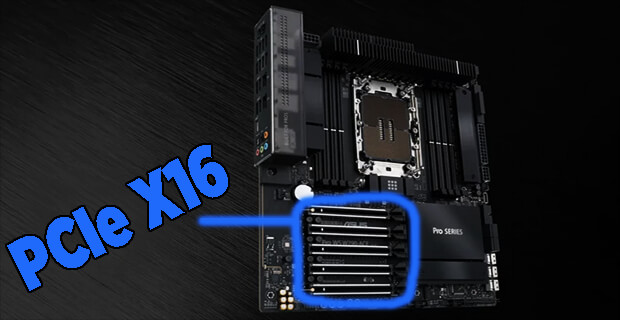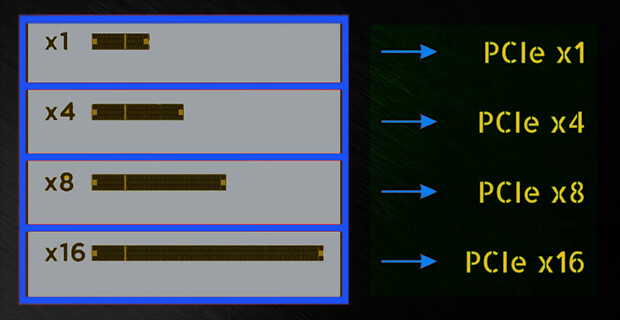PCIe (Peripheral Component Interconnect Express) x16 is a high-speed expansion slot commonly found on modern motherboards and used primarily for connecting graphics cards. Although it can also be used for other high-performance add-in cards. Let’s unravel the power of PCIe x16 by discussing its key details and features:
What Does “x16” Mean?

The “x16” designation in PCIe x16 refers to the number of physical lanes or pathways available for data transmission. Specifically, it indicates that there are 16 data lanes for data to travel between the expansion card and the motherboard. This high number of lanes translates to significant bandwidth. Which is making PCIe x16 the preferred choice for demanding tasks like gaming, 3D rendering, and high-performance computing.
Physical Connector:
PCIe x16 slots are typically long, with 164 pins in the slot itself. Manufacturers usually color them to indicate the primary graphics card slot on the motherboard, often in blue. The physical connector designed to accommodate x16-sized cards, but it can also accept smaller PCIe cards (e.g., x8, x4, or x1) through its open-ended design.
Different versions of PCIe x16 slots can be compared as follows:

A. PCIe x16 Gen 1:
- Single Direction Speed: 4 Gigabytes per second
- Dual Direction Speed: 8 Gigabytes per second
- Release Date: 2003
- PCIe Gen 1 was introduced in 2003, offering a significant increase in bandwidth and often coexisting with regular PCI slots on motherboards.
B. PCIe x16 Gen 2:
- Single Direction Speed: 8 Gigabytes per second
- Dual Direction Speed: 16 Gigabytes per second
- Release Date: 2007
- PCIe Gen 2 was released in 2007 and provided double the speed of Gen 1, supporting older peripherals alongside non-Express PCI slots.
C. PCIe x16 Gen 3:
- Single Direction Speed: 16 Gigabytes per second
- Dual Direction Speed: 32 Gigabytes per second
- Release Date: 2010
- PCIe Gen 3, launched in 2010, introduced modern features and had a lengthy lifespan, including support for NVMe M.2 slots on motherboards.
D. PCIe x16 Gen 4:
- Single Direction Speed: 32 Gigabytes per second
- Dual Direction Speed: 64 Gigabytes per second
- Release Date: 2017
- PCIe Gen 4, the current standard in motherboards since 2017, offers the necessary bandwidth for modern GPUs and high-end NVMe storage.
E. PCIe x16 Gen 5:
- Single Direction Speed: 64 Gigabytes per second
- Dual Direction Speed: 128 Gigabytes per second
- Release Date: 2019
- PCIe Gen 5, released in 2019, provides even higher bandwidth, though GPUs available at the time couldn’t fully utilize it.
F.PCIe x16 Gen 6:
- Single Direction Speed: 128 Gigabytes per second
- Dual Direction Speed: 256 Gigabytes per second
- Release Date: 2021 (Announced but not yet available)
- PCIe Gen 6, the latest standard, has been announced but isn’t currently available. It’s not expected to see widespread usage until at least 2023, with consumer boards possibly it in 2024.
Read Also: How to Clean the Motherboard [Ultimate Guide]
PCIe x16 Definition & Capacity –
PCIe x16, short for “Peripheral Component Interconnect Express x16,” is a crucial term in computer hardware. In essence, PCIe lanes or slots serve as connectors for devices that enhance or expand a computer system’s capabilities. The PCIe x16 slot is popular for its high capacity and offers the fastest data throughput rate on a motherboard.
Here are some important details about what PCIe x16 means and its capacity:
PCIe x16 is a motherboard slot that consists of 16 PCIe lanes. This slot provides the highest data transfer rate. It is commonly used for expansion cards that demand significant bandwidth, such as graphics cards.
It can accommodate cards up to 312 mm in length. However, some cards may not fit in specific instances or may obstruct other slots or ports on the motherboard.
This slots can also support other high-performance cards, including heavy-duty networking or storage cards.
You can employ it for multiple GPUs in setups such as SLI (Scalable Link Interface) for NVIDIA graphics cards or CrossFire for AMD graphics cards. These technologies facilitate the collaboration of two or more graphics cards to enhance overall performance.
Nonetheless, it’s essential to note that not all graphics cards or motherboards are compatible with SLI or CrossFire, and in some cases, additional bridges or connections may be necessary.
A PCIe x16 slot typically measures 89mm in length and contains 82 connector pins, each serving various functions related to data connections and power supply.
Optimal graphics card performance necessitates high-speed data transfer rates. User commonly use the x16 slot to connect them to the computer motherboard. It’s perfectly normal if this seems somewhat complex at first glance. Understanding PCIe x16 can be a bit challenging initially.
Conclusion:
In conclusion, PCIe x16 is a key component in computer hardware, offering 16 PCIe lanes for high-speed data transfer. Users commonly utilize these slots for graphics cards and various other expansion cards, thus enhancing system performance.
You can identify PCIe x16 slots on a motherboard by using visual inspection or system profiler tools like CPU-Z. Overall, it plays a vital role in system expansion and performance optimization.
Read: How to Tell if Motherboard is Dead [Ultimate Check]
FAQs –
Question: What is the difference between PCIe and PCIe x16?
Answer: The main difference between PCIe and PCIe x16 is the number of data lanes available. PCIe x16 has 16 lanes, providing more bandwidth, while PCIe encompasses the general interface standard with various lane configurations.
Question: What does PCI Express 4.0 x16 mean?
Answer: This refers to a PCIe slot supporting the fourth generation of the PCI Express interface with 16 lanes. It offers increased data transfer rates suitable for high-performance applications.
Question: What is the difference between PCIe x16 and PCIe x4?
Answer: PCIe x16 has 16 lanes, offering higher bandwidth, while PCIe x4 has only 4 lanes, making it suitable for less bandwidth-intensive devices like certain SSDs or network adapters. Devices can often work in slots with fewer lanes but at reduced performance.
